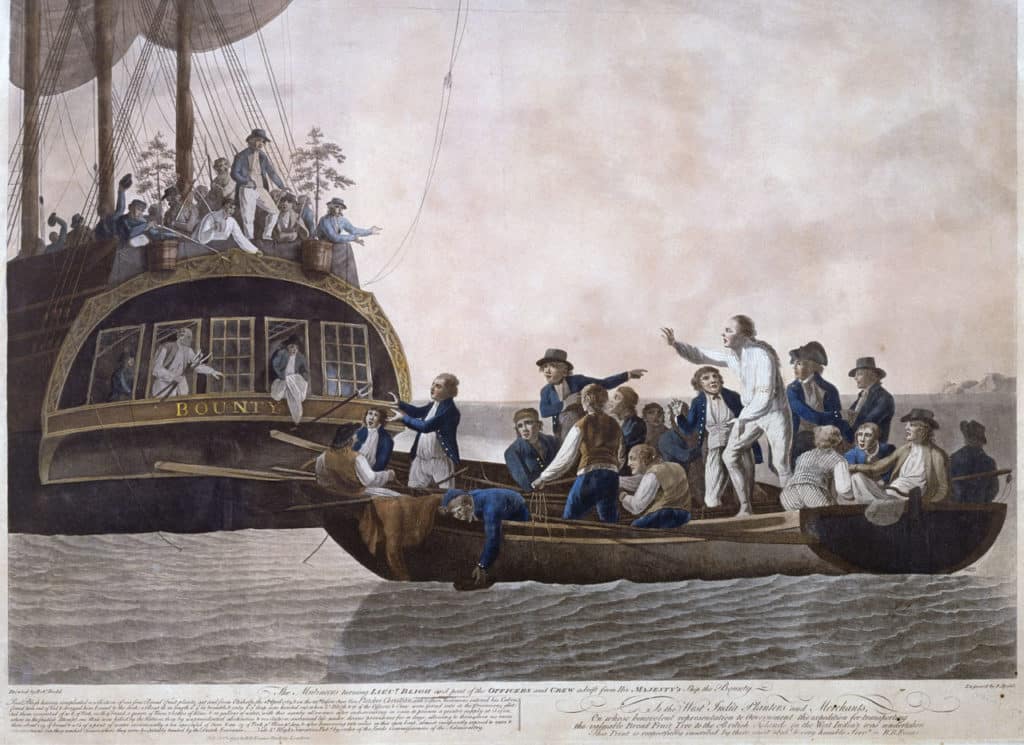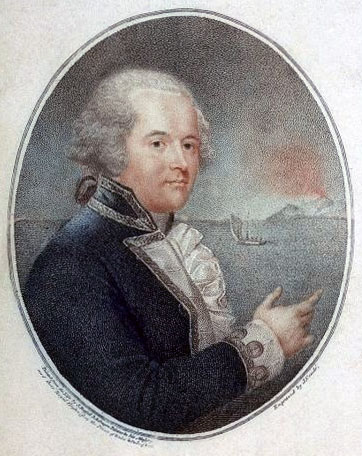
Fletcher Christian and the mutineers abandon Captain William Bligh and 18 sailors who had remained loyal to him adrift on April 28, 1789; engraving by Robert Dodd (1790).

William Bligh, Captain of the Bounty.
A Homeric Journey
When H.M.S. Bounty left England in November 1787, neither her captain nor her crew could have guessed that their peaceful journey would end in court-martial and result in generations of settlers on Tahiti, a remote island in the South Pacific.
Cape to the island of Tahiti
The Bounty was a Royal Navy frigate. His mission was to collect breadfruit seedlings in Tahiti and then transport them to the British West Indies where they would serve as food for slaves.
Veteran Captain William Bligh had been tasked with making a voyage to collect fruit and plans of breadfruit (Uru in Tahitian), a variety of fig-flavored tropical fruit. The British Crown saw this as cheap, nutritious rations for slaves on the sugar cane plantations of the British West Indies.
For this peaceful mission, on board, forty-six men, including two botanists, but no officer except Bligh. The ship was sailing alone, without the protection of another Royal Navy vessel. Bligh planned a peaceful trip to Tahiti, which Captain James Cook had visited in 1769. The island was seen by British sailors as a paradise rich in breadfruit.
After a crossing of almost a year and ten days under the storm, the ship arrived in Tahiti in October 1788 and stopped there for five months. The island was as heavenly as the crew imagined. They took full advantage of it. The sailors enjoyed a good life and many bonded with the locals. They also established ties with the women of the island, who exchanged sexual favors with them for certain objects, such as nails. During the day, the crew harvested the breadfruit and took care of the plants. At night they had fun. This paradisiacal life had as its corollary the deterioration of relations between the crew, the officers and Captain Bligh.
The origin of the mutiny
When the Bounty set sail again on April 1, 1789, the idea of a mutiny had already germinated in the minds of the crew. The sailors showed their hostility when Captain Bligh, striving to restore discipline, became more and more severe. Despite Christian’s initial friendship with Captain Bligh, as they sailed their relationship became strained. During the trip, the captain was “critical, insulting, mean-spirited and condescending. He made Fletcher Christian a scapegoat, punishing him in front of the entire crew. On April 27, he accused Christian of stealing the ship’s supply of coconuts and punished the entire crew for the theft. Three weeks after leaving Tahiti, he fomented a mutiny in which more than half of the sailors took part.
Although the real cause of the mutiny is still debated by historians, it seems clear to them that for Christian, his captain’s accusation was the final blow. On April 28, a group of rebels commanded by Christian armed themselves with muskets that were on the Bounty to land in Bligh’s cabin and take him prisoner. Christian allegedly told Bligh “I’ve been in hell with you for months.”
Then came the chaos. The ship’s crew split into two factions: one loyal to Bligh, the other determined to desert. The twenty-three mutineers isolated the captain and eighteen other men on a boat. They gave them some rations and a sextant to help with navigation, after which they sent the boat out to sea. The Bounty was in rebel hands.
Christian and his crew, which included a few hostages still loyal to Bligh, wished to establish a colony. They set their sights on Tubuai, the island of Tonga, more than 600 km south of Tahiti. There they encountered a group of hostile natives, whom they killed. They returned to Tahiti in search of workers and supplies. The rebels covered up their mutiny and lied about their mission because they were sure that the Tahitian leaders, who had good relations with Great Britain, would have refused to help them on learning what had happened. The British thus returned to Tubuai with thirty Tahitians. Hostilities with the islanders and divisions within the crew worsened day by day. The men soon gave up the struggle to settle in Tubuai.
When the rebels returned to Tahiti, they discovered that their lie had been exposed. Thinking another mutiny was brewing, a desperate Christian lured a group of Tahitians aboard the Bounty to feast, before taking them prisoner and setting sail. Sixteen British sailors were left behind in Tahiti.
At the same time, Bligh and his followers continued their frantic journey on their side. First, they headed to another island in Tonga. They left her quickly after the hostile encounter with her occupants, who stoned the ship’s quartermaster. The rations were dwindling. The crew therefore decided to set sail for a Dutch colony in Timor, more than 6,000 km away. After forty-seven days they landed and exposed the mutiny to the Crown.
Several sailors perished on the return trip to England, but Bligh survived. “I lost the Bounty,” he wrote to his wife just before he left for the UK. “My conduct has been exemplary, and I have shown all that, devoted as I have been, I have defied all enemies to harm me. »
Aftermath
Upon arrival, Bligh was court-martialed for abandoning ship and acquitted. The H.M.S. Pandora set sail from England on a mission to capture the mutineers. When the crew landed in Tahiti in March 1791, they took fourteen mutineers prisoners, whom Christian had abandoned. The Pandora sank soon after, after colliding with the Great Barrier Reef. Four of the still chained captives drowned.
In September 1792, the ten men back on English soil were tried by court-martial. Under English law, any man left on the ship was convicted of mutiny, whether or not he actively participated in it. Four of the mutineers were acquitted, the other six sentenced to death by hanging. Three of the six convicted were eventually pardoned. The remaining three, Thomas Burkett, John Millward, and Thomas Ellison, were hanged on October 29, 1794.
Meanwhile, the rest of the mutineers and their Tahitian prisoners had found refuge on Pitcairn Island, lost in the South Pacific. This deserted and verdant island had everything of a paradise. The rebels quickly burned the Bounty there and settled there.
However, the tensions that had marred their trip persisted on the island. The Tahitians whom the mutineers had taken captive blamed the British for having abused their wives, whom they had treated as sex objects. Tevarua, a Tahitian, would even have killed herself following the violence she had suffered. In September 1793, the Tahitians assassinated four of the eight mutineers, including Christian. Over the next decade, all of the rebels died except John Adams.
The descendants of the mutineers settled on Pitcairn Island, abandoning it many times before returning in search of provisions and land to cultivate. They still live on the small island today, considered a British Overseas Territory populated by around 50 people. In 1957, Luis Marden, National Geographic explorer, found the remains of the Bounty, at least what was left of it, off the east coast of the island.
Today, the Bounty’s story is remembered for its notorious place in Britain’s colonial past, but also for its drama. In 2017, historian Diana Preston spoke to National Geographic. Between disease, the landing of Christian missionaries, and the sexual exploitation of women, European explorers “in effect destroyed everything that people had found exotic and attractive in Tahitian culture.”
HMS Bounty
His Majesty’s Armed Vessel (HMAV) Bounty or Her Majesty’s Ship (HMS) Bounty was originally a collier called Bethia which was built at Blaydes Dockyard in Kingston, Yorkshire in 1784; the ship was renamed in May 1787 after its acquisition by the Royal Navy for the sum of 1,950 pounds. The ship was a three-master, 28 meters long, 7.6 meters wide and 230 tons. Its armament consisted of four guns of four pounds on carriage and ten swivel guns of half a pound without counting the muskets carried by the crew. Being registered at the Admiralty as a cutter — the lowest rank used by the Royal Navy — the Bounty was commanded by a lieutenant rather than a captain, and the latter was also the only officer on board. Moreover, the cutters did not embark the usual detachment of Royal Marines used by the commanders to make themselves obey.
The Bounty had been purchased to transport breadfruit seedlings from the Polynesian island of Tahiti in the South Pacific to British colonies in the West Indies. The expedition was supported by the Royal Society and was organized by its president Joseph Banks to provide cheap food for the slaves (Banks owned sugar cane plantations in Jamaica). For this mission, the Bounty was modified under the supervision of Banks at the Deptford shipyard on the Thames. The large cabin usually forming the captain’s quarters was transformed into a greenhouse capable of accommodating more than a thousand potted plants. This reduction in space meant that the crew, the petty officers and the captain would have to put up with great promiscuity during the long months of crossing.
Why the Bounty Lodge?
First because the HMS Bounty anchored in the bay opposite the Bounty Lodge at PK5 in Arue, then as a nod to the co-author of the book “Mutinies on the Bounty” James Norman Hall, who lived on the property adjoining the Bounty Lodge.

Servitude Paruau – Arue – PK5
Tahiti – French Polynesia
Additional services
Payment by credit card with Systempay Secure Payment

Secure payment in cryptocurrency with Coinbase Commerce

Bounty Lodge ® – Copyright – Made by Tahiticom










